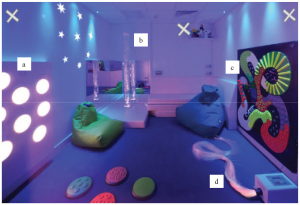Patterns of equipment use for autistic children in multi-sensory environments: Time spent with sensory equipment varies by sensory profile and intellectual ability
(IF:5.2)
Katy L Unwin, Georgina Powell, Catherine RG Jones
Abstract
Multi-sensory environments are widely used with autistic children. However, there are no data on how autistic children choose to spend time in the room and how this relates to their sensory, behavioural and intellectual profiles. We observed the frequency and duration of visits to multi-sensory environment equipment of 41 autistic children during 5 min of free play. At a group level, the bubble tube and touch, sound and light board were both highly popular, with the fibre optics and tactile board receiving less attention. Sensory seeking behaviours were more commonly observed in the multi-sensory environment than sensory-defensive behaviours. We found that observed sensory seeking behaviours, along with parent-reported sensory behaviours and non-verbal intelligence quotient, were associated with specific patterns of multi-sensory environment equipment use, but broader autistic behaviours were not. These data suggest that the multi-sensory environment equipment preferences of autistic children are related to individual differences in sensory behaviour and non-verbal intelligence quotient. This information has the potential to inform the development of best-practice multi-sensory environment guidelines that focus on individual needs.
多感官环境广泛用于孤独症儿童。然而,没有关于孤独症儿童如何选择在房间里度过时间以及这与他们的感官、行为和智力特征有何关系的数据。我们观察了 41 名孤独症儿童在5分钟的自由游戏中访问多感官环境设备的频率和持续时间。在群体层面上,气泡管和触摸、声音和光板都非常受欢迎,而光纤和触觉板则较少受到关注。在多感官环境中,感官寻求行为比感官防御行为更常见。我们发现,观察到的感官寻求行为,以及父母报告的感官行为和非语言智力商数,与多感官环境设备使用的特定模式有关,但更广泛的孤独症行为则不然。这些数据表明,孤独症儿童的多感官环境设备偏好与感官行为和非语言智商的个体差异有关。这些信息有可能为制定专注于个人需求的最佳实践多感官环境指南提供信息。
Lay abstract
Multi-sensory environments, often called sensory rooms, are widely used with autistic children. However, we know very little about how autistic children choose to spend their time in multi-sensory environments. We also do not know how their equipment preferences relate to their individual characteristics such as their sensory differences, level of ability or general autistic behaviours. We measured the frequency and duration of visits to multi-sensory environment equipment of 41 autistic children during 5 min of free play. The bubble tube and touch, sound and light board were both highly popular, with the fibre optics and tactile board receiving less attention. The children displayed significantly more sensory seeking behaviours in the multi-sensory environment than sensory-defensive behaviours. These sensory seeking behaviours, as well as the sensory behaviours that their parents reported they showed in daily life, were associated with specific patterns of multi-sensory environment equipment use. Non-verbal ability was also associated with multi-sensory environment equipment use, but broader autistic behaviours were not. Our findings show that the multi-sensory environment equipment preferences of autistic children are related to individual differences in sensory behaviours and non-verbal ability. This information could be useful for teachers and other practitioners who want to know how best to use multi-sensory environments with autistic children.
多感官环境,通常称为感官室,广泛用于孤独症儿童。然而,我们对孤独症儿童如何选择在多感官环境中度过时间知之甚少。我们也不知道他们的设备偏好如何与他们的个人特征相关,例如他们的感官差异、能力水平或一般自闭症行为。我们测量了 41 名孤独症儿童在 5 分钟的自由游戏中访问多感官环境设备的频率和持续时间。气泡管和触控板、声音板和光板都非常受欢迎,而光纤和触觉板则较少受到关注。儿童在多感官环境中表现出比感官防御行为更多的感官寻求行为。这些感官寻求行为,以及他们的父母报告他们在日常生活中表现出的感官行为,都与多感官环境设备使用的特定模式有关。非语言能力也与多感官环境设备的使用有关,但更广泛的孤独症行为则不然。我们的研究结果表明,孤独症儿童的多感官环境设备偏好与感官行为和非语言能力的个体差异有关。这些信息对于想知道如何最好地与孤独症儿童使用多感官环境的教师和其他从业者可能很有用。
图1:多感官环境的图像
包括(a)触摸,声光板,(b)气泡管,(c)触觉板和(d)光纤。“X”标记摄像机定位,所有摄像机都指向外和向下。

